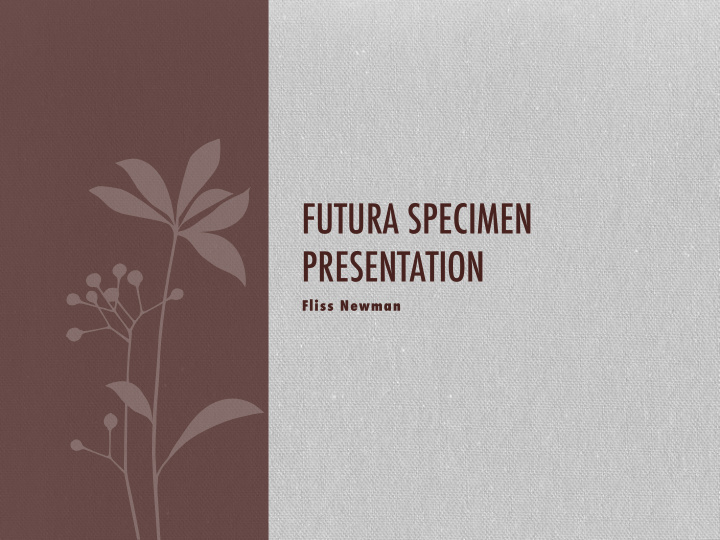



FUTURA SPECIMEN PRESENTATION � Fliss Newman �
1. Why? – Idea/Response to the brief � The Brief: � Design and produce a 12-page (minimum) “specimen” for a typeface. Choose a typeface that has a substantial number of variations, such as but not limited to Univers, Helvetica, Caslon, Baskerville, Garamond, Futura, Bodoni, or Gill Sans � � My Response: � A timeline idea. Starting off with when it was created. � • Then looking at the history and the background of the designer Paul Renner � • The history and background of the typeface ( 1927, Bauhaus movement) � • Then it would follow the additions to the typeface in order E.G Futura bold in 1930, • then Futura Display in 1932. � Each new era, will have a different colour palette to suit it. � • Like the front cover, each page distinguishing a new letter and how it is made up of • geometric shapes. ( shape (s) underneath and the letter in another colour over the top. �
Who? � • Many of my influences have come from the internet as it is such a vast thing. � • Influences and Inspiration: � http://dribbble.com/shots/793958-Futura-type-specimen-book-layout-school-project? list=tags&tag=futura � Someone's existing work and idea on their blog. � � Looking at the idea of the shapes underneath and the • letters on the top to show which geometric shapes made the letter � I have lost the artist name, but this piece of work is inspirational as it represents my idea as a whole using a colour palette as well as the shape idea. My colour will be more defined. �
3. Experimentation � • My idea as sketched below: � Method: Sketching � Trial and Error as the more you do by hand the less you have to do on a computer screen. � ( Know your onions.) � In recent reading of Know your onions you always start off with a million ideas, and find it hard to narrow down into one. A good place to start to formulate and idea or ideas by sketching and scamping things out as a why of visualising all your ideas but also seeing which ones work. � ¡
4. Aesthetic and Technical considerations � • Layout:- Each spread of the specimen book is going to look at follows: � Grids: - They will be designed when I have decided on the layout of my content for the right hand side. Also when my content has been fully designed. � The content or the way it is laid out on the right hand side will change through designing the actual specimen book. At the moment all the characters are together, the words separate etc.. � ¡ Colour: - Each new decade that we go into, in the time line the colour palette will change to suit that era. For example below the first 1-3 pages I’m looking at the designer and the typeface context I am going to be using a 1920’s colour palette as shown below. �
5. Where do I intend to go from it? � • Hopefully a well thought out design that will flow (feedback) � • That considers both colour, and the palettes I have chosen and geometric shapes that form each letter. So development! � • I will find and work on developing a layout for the right hand side of a spread where all my content will be. � • Content? Kate has some requirements but linked to the idea of timeline and colours to suit the eras as talked about in my research will I include quirky phrases and words from each era? – I hope to! � • Make some visual representations of my overall designs using a chosen colour palette, as a matter of trial and error to see what is complimentary and what isn't. � • A fulfilled assignment brief and a complete final outcome. � • Confidence. �
Recommend
More recommend